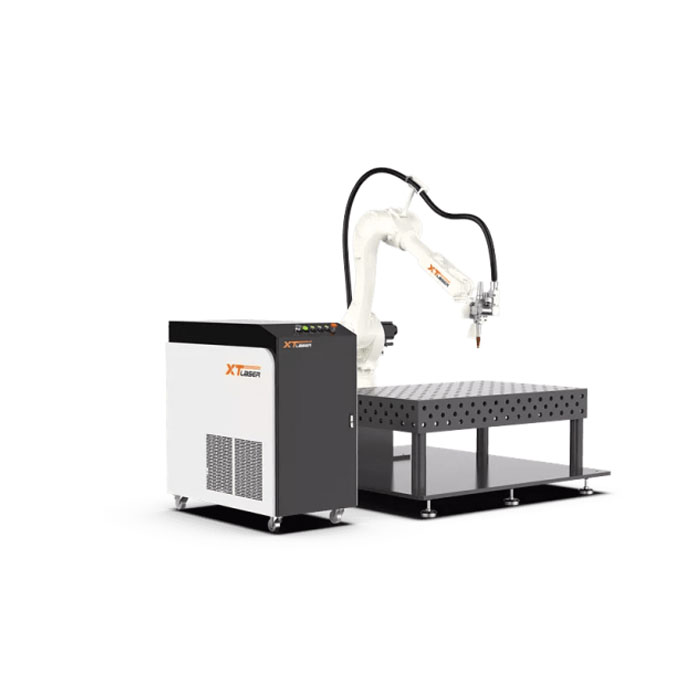The Versatility and Efficiency of Industrial Laser Welding Machines
2024-07-16
Introduction
In the ever-evolving landscape of industrial manufacturing, laser welding machines have emerged as a game-changer. Known for their precision, speed, and versatility, these machines are transforming how industries approach welding tasks. This blog delves into the various types of industrial laser welding machines, their applications, and the advantages they bring to modern manufacturing.
Types of Industrial Laser Welding Machines
1. Fiber Laser Welding Machines: These are known for their efficiency and high beam quality. Fiber lasers are highly effective for deep penetration welding and can handle a variety of materials, making them suitable for automotive, aerospace, and heavy machinery industries.
2. CO2 Laser Welding Machines: CO2 lasers are widely used for cutting and welding non-metal materials. They are ideal for applications involving wood, glass, and certain plastics, providing clean and precise welds without physical contact.
3. Diode Laser Welding Machines: These machines are valued for their compact size and energy efficiency. Diode lasers are commonly used in applications requiring lower power but high precision, such as medical device manufacturing and electronics.
4. Nd:YAG Laser Welding Machines: Nd:YAG lasers are versatile and can be used for both welding and cutting. They are particularly effective in the jewelry industry and for small-scale welding applications requiring fine control.
Applications of Laser Welding Machines
1. Automotive Industry: Laser welding machines are extensively used in the automotive sector for assembling car bodies, manufacturing engine components, and producing exhaust systems. The precision and speed of laser welding contribute to improved safety, performance, and efficiency in vehicle production.
2. Aerospace and Defense: The aerospace industry relies on laser welding for fabricating critical components such as turbine blades, fuel tanks, and structural parts. The high strength and reliability of laser welds are crucial for maintaining the safety and performance of aircraft and defense equipment.
3. Medical Device Manufacturing: Laser welding is essential for producing medical devices, implants, and surgical instruments. The precision of laser welding ensures high-quality joins, which are vital for the functionality and safety of medical products.
4. Electronics and Semiconductors: In the electronics industry, laser welding is used to assemble delicate components, including sensors, connectors, and microchips. The minimal heat input and high precision of laser welding prevent damage to sensitive electronic parts.
5. Jewelry and Watchmaking: Laser welding enables the creation of intricate designs and repairs in jewelry and watchmaking. The fine control of laser welding allows for seamless joins and detailed craftsmanship without compromising the integrity of precious metals.
Advantages of Industrial Laser Welding Machines
1. Precision and Accuracy: One of the most significant advantages of laser welding machines is their ability to produce highly precise and accurate welds. This precision is crucial in industries where even minor deviations can lead to significant issues, such as aerospace and medical device manufacturing.
2. High Welding Speed: Laser welding is significantly faster than traditional welding methods. The high-energy density of the laser allows for rapid heating and cooling, resulting in faster production cycles and increased throughput.
3. Minimal Distortion and Heat Affected Zone (HAZ): The focused nature of the laser beam minimizes the heat-affected zone and reduces thermal distortion. This is particularly beneficial for welding thin materials and components that require tight tolerances.
4. Versatility in Material Compatibility: Laser welding machines can handle a wide range of materials, including metals, plastics, ceramics, and even dissimilar material combinations. This versatility opens up new possibilities for innovative designs and applications.
5. Automation and Integration: Modern laser welding machines can be easily integrated into automated production lines. They can be controlled by CNC systems, ensuring consistent and repeatable welds, reducing the need for manual intervention and skilled labor.
6. Cost Efficiency: Although the initial investment in laser welding equipment can be substantial, the long-term benefits include reduced labor costs, higher productivity, and lower material waste. This makes laser welding a cost-effective solution for many manufacturing processes.
Case Study: Laser Welding in Automotive Manufacturing
The automotive industry is a prime example of the benefits of laser welding. A major car manufacturer implemented fiber laser welding machines in their production line, specifically for welding the car body's high-strength steel components. The results were impressive:
- Increased Production Speed: The laser welding machines significantly reduced welding times, allowing the manufacturer to increase production rates and meet higher demand.
- Improved Weld Quality: The precision of laser welding resulted in stronger and more consistent welds, enhancing the overall safety and durability of the vehicles.
- Reduced Material Waste: The accuracy of the laser welding process minimized material waste, leading to cost savings and a more sustainable manufacturing process.
Conclusion
Industrial laser welding machines are revolutionizing the manufacturing industry with their precision, speed, and versatility. From automotive and aerospace to medical devices and electronics, the applications of laser welding are vast and continue to expand. As technology advances, the adoption of laser welding machines will undoubtedly lead to more efficient, cost-effective, and high-quality manufacturing processes. Embracing this technology is not just an investment in equipment but an investment in the future of manufacturing.


